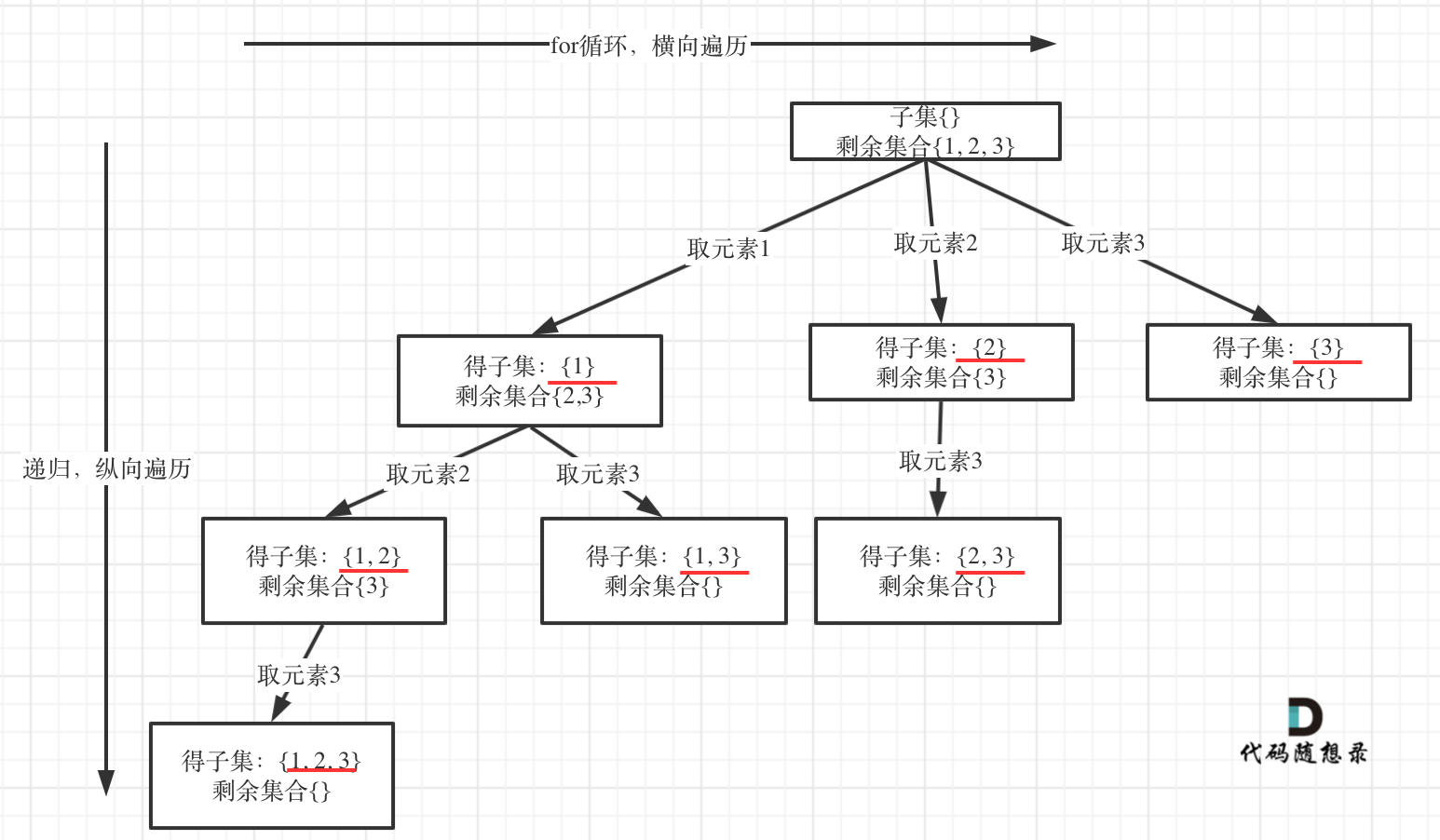- 做项目(多个C++、Java、Go、测开、前端项目) (opens new window)
- 刷算法(两个月高强度学算法) (opens new window)
- 背八股(40天挑战高频面试题) (opens new window)
# 78.子集
给定一组不含重复元素的整数数组 nums,返回该数组所有可能的子集(幂集)。
说明:解集不能包含重复的子集。
示例: 输入: nums = [1,2,3] 输出: [ [3], [1], [2], [1,2,3], [1,3], [2,3], [1,2], [] ]
# 算法公开课
《代码随想录》算法视频公开课 (opens new window):回溯算法解决子集问题,树上节点都是目标集和! | LeetCode:78.子集 (opens new window),相信结合视频再看本篇题解,更有助于大家对本题的理解。
# 思路
求子集问题和77.组合 (opens new window)和131.分割回文串 (opens new window)又不一样了。
如果把 子集问题、组合问题、分割问题都抽象为一棵树的话,那么组合问题和分割问题都是收集树的叶子节点,而子集问题是找树的所有节点!
其实子集也是一种组合问题,因为它的集合是无序的,子集{1,2} 和 子集{2,1}是一样的。
那么既然是无序,取过的元素不会重复取,写回溯算法的时候,for就要从startIndex开始,而不是从0开始!
有同学问了,什么时候for可以从0开始呢?
求排列问题的时候,就要从0开始,因为集合是有序的,{1, 2} 和{2, 1}是两个集合,排列问题我们后续的文章就会讲到的。
以示例中nums = [1,2,3]为例把求子集抽象为树型结构,如下:

从图中红线部分,可以看出遍历这个树的时候,把所有节点都记录下来,就是要求的子集集合。
# 回溯三部曲
- 递归函数参数
全局变量数组path为子集收集元素,二维数组result存放子集组合。(也可以放到递归函数参数里)
递归函数参数在上面讲到了,需要startIndex。
代码如下:
vector<vector<int>> result;
vector<int> path;
void backtracking(vector<int>& nums, int startIndex) {
2
3
递归终止条件
从图中可以看出:

剩余集合为空的时候,就是叶子节点。
那么什么时候剩余集合为空呢?
就是startIndex已经大于数组的长度了,就终止了,因为没有元素可取了,代码如下:
if (startIndex >= nums.size()) {
return;
}
2
3
其实可以不需要加终止条件,因为startIndex >= nums.size(),本层for循环本来也结束了。
- 单层搜索逻辑
求取子集问题,不需要任何剪枝!因为子集就是要遍历整棵树。
那么单层递归逻辑代码如下:
for (int i = startIndex; i < nums.size(); i++) {
path.push_back(nums[i]); // 子集收集元素
backtracking(nums, i + 1); // 注意从i+1开始,元素不重复取
path.pop_back(); // 回溯
}
2
3
4
5
根据关于回溯算法,你该了解这些! (opens new window)给出的回溯算法模板:
void backtracking(参数) {
if (终止条件) {
存放结果;
return;
}
for (选择:本层集合中元素(树中节点孩子的数量就是集合的大小)) {
处理节点;
backtracking(路径,选择列表); // 递归
回溯,撤销处理结果
}
}
2
3
4
5
6
7
8
9
10
11
12
可以写出如下回溯算法C++代码:
class Solution {
private:
vector<vector<int>> result;
vector<int> path;
void backtracking(vector<int>& nums, int startIndex) {
result.push_back(path); // 收集子集,要放在终止添加的上面,否则会漏掉自己
if (startIndex >= nums.size()) { // 终止条件可以不加
return;
}
for (int i = startIndex; i < nums.size(); i++) {
path.push_back(nums[i]);
backtracking(nums, i + 1);
path.pop_back();
}
}
public:
vector<vector<int>> subsets(vector<int>& nums) {
result.clear();
path.clear();
backtracking(nums, 0);
return result;
}
};
2
3
4
5
6
7
8
9
10
11
12
13
14
15
16
17
18
19
20
21
22
23
24
- 时间复杂度: O(n * 2^n)
- 空间复杂度: O(n)
在注释中,可以发现可以不写终止条件,因为本来我们就要遍历整棵树。
有的同学可能担心不写终止条件会不会无限递归?
并不会,因为每次递归的下一层就是从i+1开始的。
# 总结
相信大家经过了
- 组合问题:
- 分割问题:
洗礼之后,发现子集问题还真的有点简单了,其实这就是一道标准的模板题。
但是要清楚子集问题和组合问题、分割问题的的区别,子集是收集树形结构中树的所有节点的结果。
而组合问题、分割问题是收集树形结构中叶子节点的结果。
# 其他语言版本
# Java
class Solution {
List<List<Integer>> result = new ArrayList<>();// 存放符合条件结果的集合
LinkedList<Integer> path = new LinkedList<>();// 用来存放符合条件结果
public List<List<Integer>> subsets(int[] nums) {
subsetsHelper(nums, 0);
return result;
}
private void subsetsHelper(int[] nums, int startIndex){
result.add(new ArrayList<>(path));//「遍历这个树的时候,把所有节点都记录下来,就是要求的子集集合」。
if (startIndex >= nums.length){ //终止条件可不加
return;
}
for (int i = startIndex; i < nums.length; i++){
path.add(nums[i]);
subsetsHelper(nums, i + 1);
path.removeLast();
}
}
}
2
3
4
5
6
7
8
9
10
11
12
13
14
15
16
17
18
19
20
# Python
class Solution:
def subsets(self, nums):
result = []
path = []
self.backtracking(nums, 0, path, result)
return result
def backtracking(self, nums, startIndex, path, result):
result.append(path[:]) # 收集子集,要放在终止添加的上面,否则会漏掉自己
# if startIndex >= len(nums): # 终止条件可以不加
# return
for i in range(startIndex, len(nums)):
path.append(nums[i])
self.backtracking(nums, i + 1, path, result)
path.pop()
2
3
4
5
6
7
8
9
10
11
12
13
14
15
# Go
var (
path []int
res [][]int
)
func subsets(nums []int) [][]int {
res, path = make([][]int, 0), make([]int, 0, len(nums))
dfs(nums, 0)
return res
}
func dfs(nums []int, start int) {
tmp := make([]int, len(path))
copy(tmp, path)
res = append(res, tmp)
for i := start; i < len(nums); i++ {
path = append(path, nums[i])
dfs(nums, i+1)
path = path[:len(path)-1]
}
}
2
3
4
5
6
7
8
9
10
11
12
13
14
15
16
17
18
19
20
# JavaScript
var subsets = function(nums) {
let result = []
let path = []
function backtracking(startIndex) {
result.push([...path])
for(let i = startIndex; i < nums.length; i++) {
path.push(nums[i])
backtracking(i + 1)
path.pop()
}
}
backtracking(0)
return result
};
2
3
4
5
6
7
8
9
10
11
12
13
14
# TypeScript
function subsets(nums: number[]): number[][] {
const resArr: number[][] = [];
backTracking(nums, 0, []);
return resArr;
function backTracking(nums: number[], startIndex: number, route: number[]): void {
resArr.push([...route]);
let length = nums.length;
if (startIndex === length) return;
for (let i = startIndex; i < length; i++) {
route.push(nums[i]);
backTracking(nums, i + 1, route);
route.pop();
}
}
};
2
3
4
5
6
7
8
9
10
11
12
13
14
15
# Rust
思路一:使用本题的标准解法,递归回溯。
impl Solution {
fn backtracking(result: &mut Vec<Vec<i32>>, path: &mut Vec<i32>, nums: &Vec<i32>, start_index: usize) {
result.push(path.clone());
let len = nums.len();
// if start_index >= len { return; }
for i in start_index..len {
path.push(nums[i]);
Self::backtracking(result, path, nums, i + 1);
path.pop();
}
}
pub fn subsets(nums: Vec<i32>) -> Vec<Vec<i32>> {
let mut result: Vec<Vec<i32>> = Vec::new();
let mut path: Vec<i32> = Vec::new();
Self::backtracking(&mut result, &mut path, &nums, 0);
result
}
}
2
3
4
5
6
7
8
9
10
11
12
13
14
15
16
17
18
19
思路二:使用二进制枚举,n个元素的子集问题一共是$2^n$种情况。如果我们使用一个二进制数字,每一位根据0和1来决定是选取该元素与否,那么一共也是$2^n$的情况,正好可以一一对应,所以我们可以不使用递归,直接利用循环枚举完成子集问题。 这种方法的优点在于效率高,不需要递归调用,并且代码容易编写。缺点则是过滤某些非法情况时会比递归方法难写一点,不过在子集问题中不存在这个问题。
impl Solution {
pub fn subsets(nums: Vec<i32>) -> Vec<Vec<i32>> {
let n = nums.len();
// 预分配2^n空间
let mut result = Vec::with_capacity(1 << n);
// 二进制枚举,2^n种情况
for i in 0..(1 << n) {
let mut subset = Vec::new();
for j in 0..n {
// 枚举该二进制数字的每一位
// 如果该位是1,对应位置上的元素加入子集,否则跳过
if i & (1 << j) != 0 {
subset.push(nums[j]);
}
}
result.push(subset);
}
result
}
}
2
3
4
5
6
7
8
9
10
11
12
13
14
15
16
17
18
19
20
# C
int* path;
int pathTop;
int** ans;
int ansTop;
//记录二维数组中每个一维数组的长度
int* length;
//将当前path数组复制到ans中
void copy() {
int* tempPath = (int*)malloc(sizeof(int) * pathTop);
int i;
for(i = 0; i < pathTop; i++) {
tempPath[i] = path[i];
}
ans = (int**)realloc(ans, sizeof(int*) * (ansTop+1));
length[ansTop] = pathTop;
ans[ansTop++] = tempPath;
}
void backTracking(int* nums, int numsSize, int startIndex) {
//收集子集,要放在终止添加的上面,否则会漏掉自己
copy();
//若startIndex大于数组大小,返回
if(startIndex >= numsSize) {
return;
}
int j;
for(j = startIndex; j < numsSize; j++) {
//将当前下标数字放入path中
path[pathTop++] = nums[j];
backTracking(nums, numsSize, j+1);
//回溯
pathTop--;
}
}
int** subsets(int* nums, int numsSize, int* returnSize, int** returnColumnSizes){
//初始化辅助变量
path = (int*)malloc(sizeof(int) * numsSize);
ans = (int**)malloc(0);
length = (int*)malloc(sizeof(int) * 1500);
ansTop = pathTop = 0;
//进入回溯
backTracking(nums, numsSize, 0);
//设置二维数组中元素个数
*returnSize = ansTop;
//设置二维数组中每个一维数组的长度
*returnColumnSizes = (int*)malloc(sizeof(int) * ansTop);
int i;
for(i = 0; i < ansTop; i++) {
(*returnColumnSizes)[i] = length[i];
}
return ans;
}
2
3
4
5
6
7
8
9
10
11
12
13
14
15
16
17
18
19
20
21
22
23
24
25
26
27
28
29
30
31
32
33
34
35
36
37
38
39
40
41
42
43
44
45
46
47
48
49
50
51
52
53
# Swift
func subsets(_ nums: [Int]) -> [[Int]] {
var result = [[Int]]()
var path = [Int]()
func backtracking(startIndex: Int) {
// 直接收集结果
result.append(path)
let end = nums.count
guard startIndex < end else { return } // 终止条件
for i in startIndex ..< end {
path.append(nums[i]) // 处理:收集元素
backtracking(startIndex: i + 1) // 元素不重复访问
path.removeLast() // 回溯
}
}
backtracking(startIndex: 0)
return result
}
2
3
4
5
6
7
8
9
10
11
12
13
14
15
16
17
18
# Scala
思路一: 使用本题解思路
object Solution {
import scala.collection.mutable
def subsets(nums: Array[Int]): List[List[Int]] = {
var result = mutable.ListBuffer[List[Int]]()
var path = mutable.ListBuffer[Int]()
def backtracking(startIndex: Int): Unit = {
result.append(path.toList) // 存放结果
if (startIndex >= nums.size) {
return
}
for (i <- startIndex until nums.size) {
path.append(nums(i)) // 添加元素
backtracking(i + 1)
path.remove(path.size - 1) // 删除
}
}
backtracking(0)
result.toList
}
}
2
3
4
5
6
7
8
9
10
11
12
13
14
15
16
17
18
19
20
21
22
思路二: 将原问题转换为二叉树,针对每一个元素都有选或不选两种选择,直到遍历到最后,所有的叶子节点即为本题的答案:
object Solution {
import scala.collection.mutable
def subsets(nums: Array[Int]): List[List[Int]] = {
var result = mutable.ListBuffer[List[Int]]()
def backtracking(path: mutable.ListBuffer[Int], startIndex: Int): Unit = {
if (startIndex == nums.length) {
result.append(path.toList)
return
}
path.append(nums(startIndex))
backtracking(path, startIndex + 1) // 选择元素
path.remove(path.size - 1)
backtracking(path, startIndex + 1) // 不选择元素
}
backtracking(mutable.ListBuffer[Int](), 0)
result.toList
}
}
2
3
4
5
6
7
8
9
10
11
12
13
14
15
16
17
18
19
20
# C#
public class Solution {
public IList<IList<int>> res = new List<IList<int>>();
public IList<int> path = new List<int>();
public IList<IList<int>> Subsets(int[] nums) {
BackTracking(nums, 0);
return res;
}
public void BackTracking(int[] nums, int start){
res.Add(new List<int>(path));
if(start > nums.Length) return;
for (int i = start; i < nums.Length; i++)
{
path.Add(nums[i]);
BackTracking(nums, i + 1);
path.RemoveAt(path.Count - 1);
}
}
}
2
3
4
5
6
7
8
9
10
11
12
13
14
15
16
17
18
← 10. 复原IP地址 12. 回溯周末总结 →
